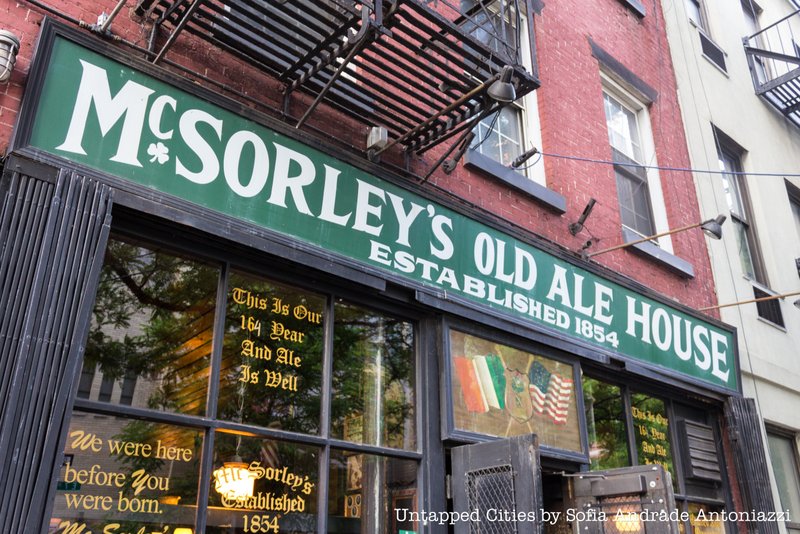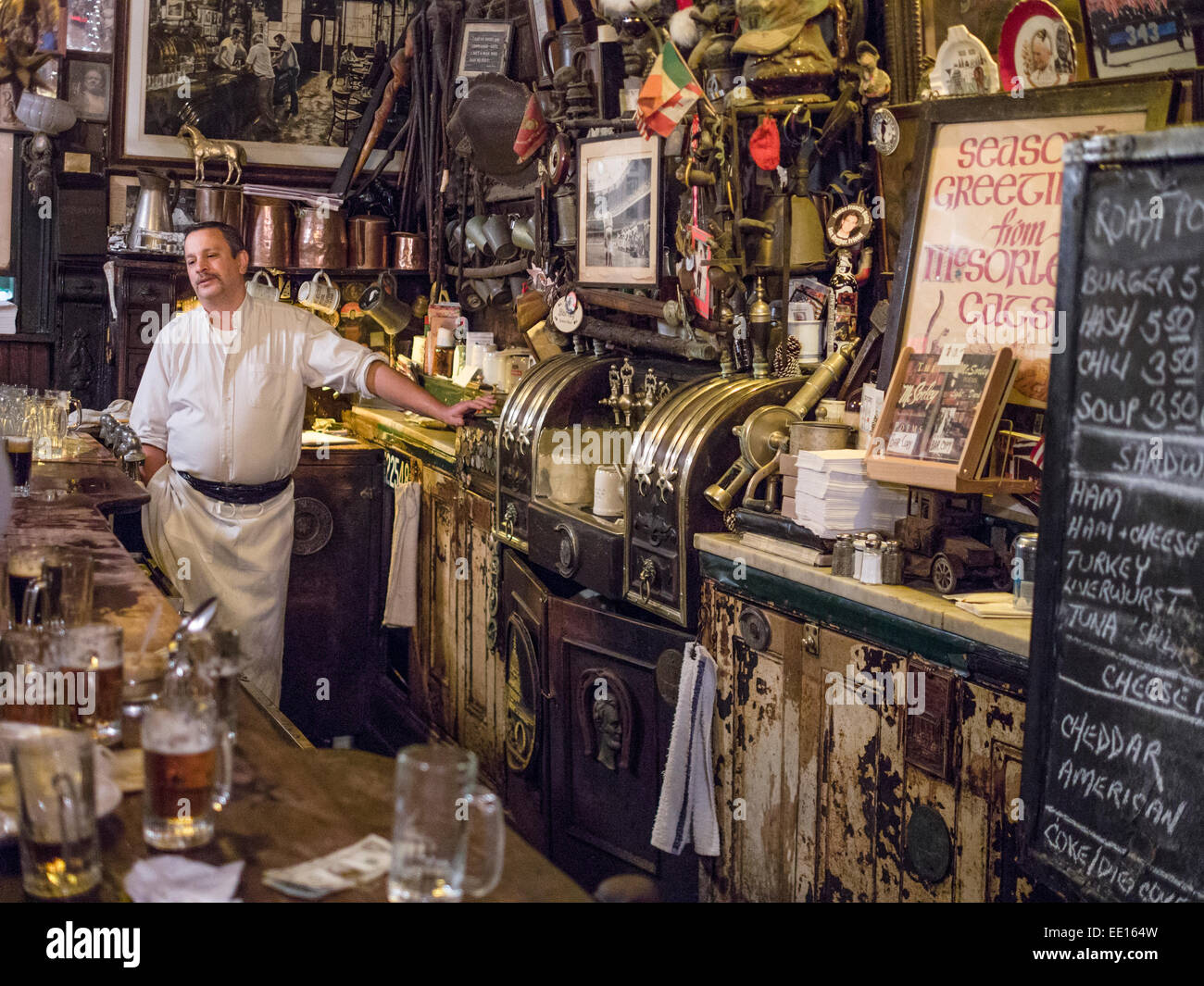Table Of Content

It has also attracted many political guests including Abraham Lincoln, Ulysses S. Grant and Theodore Roosevelt. The memories of ex-presidents, popular society figures, entertainers and athletes mingle with the working class, as the poets and artists mix in to enjoy the same old ale as those before them. Every visit to McSorley’s reveals new history which may have been missed on a prior visit. Once again, a story can be told by what you won’t find at McSorley’s. The only other drink available, in addition to the two ales, is soda, and a limited, reasonably-priced food menu is posted daily on two chalkboards.
McSorley’s Old Ale House
Many photographs of him are in existence, and it is obvious that he had a lot of unassumed dignity. He patterned his saloon after a public house he had known in Ireland and originally called it the Old House at Home; around 1908 the signboard blew down, and when he ordered a new one he changed the name to McSorley’s Old Ale House. That is still the official name; customers never have called it anything but McSorley’s. Old John believed it impossible for men to drink with tranquillity in the presence of women; there is a fine back room in the saloon, but for many years a sign was nailed on the street door, saying, “Notice. When other women came in, Old John would hurry forward, make a bow, and say, “Madam, I’m sorry, but we don’t serve ladies.” This technique is still used.
History
Almost every inch of the walls was adorned with old photos, newspaper clippings, pictures of Irish American presidents, and festive St. Patrick's Day decorations. A large flag hung behind the bar with the number 169 on it — the number of years the bar has been open. When I visited McSorley's, the bar was teeming with people and there were very few places to sit. I'm always a little hesitant about ordering bar food – you just never know what you're going to get, especially from places popular with tourists — but I was surprised by how much I liked the burger.
New York's oldest Irish pub McSorley's Old Ale House celebrates 169 years
In 2011, New York City passed a law forbidding bars and restaurants from keeping cats. Minnie was forced out and, five years later, the Department of Health closed McSorley’s for four days while they resolved a rodent problem. Perhaps the most famous artifacts are the wishbones dangling from a gas lamp above the bar. After finishing a free meal at the bar, soldiers departing to serve in WWI left their wishbones—from turkeys, chickens, and one duck—intending to collect them upon their safe return. In 2011, a city health inspector insisted that the wishbones, encased in years of dust, be cleaned. McSorley’s has all the hallmarks of a classic tourist attraction, but Buggy says it’s the regulars who really make the place special.
Dust Is Gone Above the Bar, but a Legend Still Dangles (Published 2011) - The New York Times
Dust Is Gone Above the Bar, but a Legend Still Dangles (Published .
Posted: Thu, 07 Apr 2011 07:00:00 GMT [source]
The Piece of Cheese Cottage
Though its wooden walls and doors may be etched and notched by wear, its beauty and nostalgia endure in the smooth ale poured and the patrons who were there—lending truth to its motto, we have been here before you were born. It rode the fervor of Abraham Lincoln’s historic Cooper Union Address delivered in New York City. They served the 16th president their signature brew, only to later lament the fateful news of his assassination in April of 1865. Strangely, Lincoln shares this similarity to JFK, who was also rumored to have tasted McSorley’s toasted lager. They hang from an iron chandelier above the bar forbidden to be touched.
Opened to women
There are no TVs at McSorley’s and no ambient music—the only noises you’ll hear are the clinking of glasses and the muted hum of people’s conversations. But on a Tuesday afternoon, it’s easy enough to grab a couple of beers, settle into a worn wooden table, and imagine the people who have passed through its double doors in need of “a cold beer to warm up”—a phrase Buggy uses frequently. At the very least, McSorley’s can claim the title of “oldest Irish pub” in the city. It’s no surprise that McSorley’s—with its green, shamrock-emblazoned storefront—is a popular destination on St. Patrick’s Day. McSorley’s is not the oldest bar in New York City—that distinction goes to Fraunces Tavern, open since 1762—although Shane Buggy, a bartender at McSorley’s, disputes this fact.

Paddy Reilly's Music Bar
I actually enjoyed the lack of choice, which made ordering fast and simple. When Business Insider's Sarah Jacobs visited in 2017, the beer cost $5.50. She noted that the beer cost only a dime per mug in 1940, and in 1966, two of the half-pints cost 35 cents.
History of New York City

He bought a fire-alarm gong similar to those used in schools and factories and screwed it to the seven-foot-tall icebox behind the bar. If someone started a song, or if the old men sitting around the stove began to yell at each other, he would shuffle over to the gong and give the rope a series of savage jerks. The gong is there yet and is customarily sounded at a quarter to midnight as a warning that closing time is imminent; the customers grab their ears when it goes off.
Celebrate St. Patrick's Day in NYC 2024 - Untapped New York - Untapped New York
Celebrate St. Patrick's Day in NYC 2024 - Untapped New York.
Posted: Fri, 15 Mar 2024 07:00:00 GMT [source]
NYC Chefs Dish On What It’s Like To Run a Business With a Significant Other
Drunks reel over from the Bowery and go to sleep in doorways, and the kids give them hotfoots with kitchen matches. In McSorley’s the free-lunch platters are kept at the end of the bar nearer the street door, and several times every afternoon kids sidle in, snatch handfuls of cheese and slices of onion, and dash out, slamming the door. It’s also easy to imagine who hasn’t visited McSorley’s over the years. The pub, whose motto was “Good Ale, Raw Onions, and No Ladies,” was not yet ready to get with the times.
He unlocked the saloon at seven, swept it out himself, and spread sawdust on the floor. Until he became too feeble to manage a racing sulky, he always kept a horse and a nanny goat in a stable around the corner on St. Mark’s Place. He kept both animals in the same stall, believing, like many horse-lovers, that horses should have company at night. During the lull in the afternoon a stable-hand would lead the horse around to a hitching block in front of the saloon, and Old John, wearing his bar apron, would stand on the curb and groom the animal.
In 1939, when then-owner Daniel O’Connell died and left the bar to his daughter, Dorothy O’Connell Kirwan, she honored the no-women policy and appointed her husband as manager. When the bar celebrated its centennial, Kirwan had her celebratory drink outside on the sidewalk. After women were finally admitted, Kirwan declined to be the first woman served, a decision that makes more sense if you know that the first women’s restroom wasn’t added until 16 years later. The legendary backroom (where the ale flowed during prohibition), is adorned with the infamous, and very risque (for its time), portrait of a nude with her parrot. The old fireplace is also in the backroom-that’s where the original owner-John McSorley held court (as witnessed in a well-known John Sloan sketch nearby). Above the fireplace is the McSorley’s motto “Be Good or Be Gone”, as well as a portrait of Peter Cooper, founder of Cooper Union.
To a steady McSorley customer, most other New York saloons seem feminine and fit only for college boys and women; the atmosphere in them is so tense and disquieting that he has to drink himself into a coma in order to stand it. In McSorley’s, the customers are self-sufficient; they never try to impress each other. In other saloons if a man tells a story, good or bad, the man next to him laughs perfunctorily and immediately tries to tell a better one. For one thing, it is dark and gloomy, and repose comes easy in a gloomy place. Also, there is a thick, musty smell that acts as a balm to jerky nerves; it is really a rich compound of the smells of pine sawdust, tap drippings, pipe tobacco, coal smoke, and onions.
There are no bad seats (providing you can get one) and no bad views. From every wall, to each nook-and-cranny — history pours as freely as ale from the taps. The 1940’s brought with it a world war and a new brewer of McSorley’s Ale.
I asked him what he’d been drinking and he said, ‘Near beer in McSorley’s.’ ” The prohibition ale cost fifteen cents, or two mugs for a quarter. McSorley’s Old Ale House reveals a lot about New York history as its walls capture many of the greatest moments in American history. As the walls are covered with newspaper articles, photographs, records, and more, a visit to McSorley’s is an educational experience. To this day, McSorley’s is the only New York City bar that still throws saw dust on the floor. It is another lasting tradition that McSorley’s has kept since its founding. The tradition started back when many customers were chewing tobacco and spit would go flying everywhere.
The two-glass policy evolved so father and son could tend to their hobbies in between pours. The lawsuit compelled New York City Mayor John V. Lindsay to sign an executive order prohibiting discrimination on the basis of sex in bars and other public accommodations. At 3pm the next day, McSorley’s opened its doors to women for the first time. Kirwan was not present, explaining that she did not wish to break the bar’s tradition.
Fraunces Tavern has been rebuilt several times, but McSorley’s has remained virtually unchanged—and has served ale continuously, even during Prohibition—for 165 years. According to legend, bartenders would step on a special pedal to fill the mugs with the real deal to longtime customers. McSorley’s managed to avoid legal trouble because many of Tammany Hall politicians drank there throughout Prohibition.

No comments:
Post a Comment